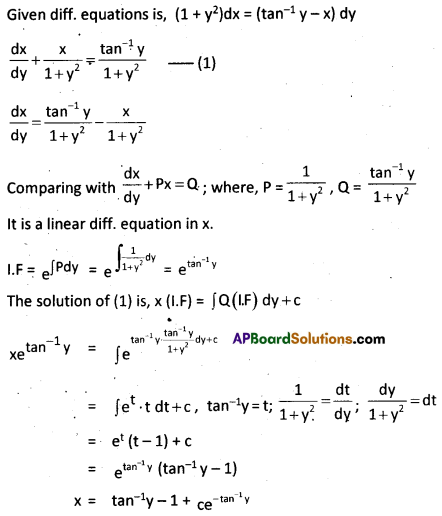Access to a variety of AP Inter 2nd Year Maths 2B Model Papers and AP Inter 2nd Year Maths 2B Question Paper March 2015 allows students to familiarize themselves with different question patterns.
AP Inter 2nd Year Maths 2B Question Paper March 2015
Time : 3 Hours
Max. Marks : 75
Note: This question paper contains three sections A, B and C.
Section – A
(10 × 2 = 20)
I. Very Short Answer type questions.
- Attempt ALL questions.
- Each question carries TWO marks.
Question 1.
Find the value of ‘a’ if 2x2 + ay2 – 3x + 2y -1 = 0 represents a circle and also find its radius.
Solution:
Given equation is 2x2 + ay2 – 3x + 2y – 1 = 0 …….. (1)
Comparing the (1) with ax2 + 2hxy + by2 + 2gx + 2fy + c = 0
We get a = 2, h = 0, b = a, g = \(\frac{-3}{2}\), f = 1, c = -1
Now, equation (1) represents a circle then
a = b; 2 = a ∴ a = 2
The equation of the circle is 2x2 + 2y2 – 3x + 2y – 1 = 0
x2 + y2 – \(\frac{3}{2}\)x + y – \(\frac{1}{2}\) = 0
Comparing the above equation with x2 + y2 + 2gx + 2fy + c = 0

Question 2.
If the length of a tangent from (5, 4) to the circle x2 + y2 + 2ky = 0 is ‘1’, then find ‘k’.
Solution:
The given equation of the circle is x2 + y2 + 2ky = 0
Comparing the given equation with x2 + y2 + 2gx + 2fy + c = 0
We get g = 0, f = k, c = 0
Let, the given point P(x1, y1) = (5, 4)
Given that, the length of the tangent = 1
\(\sqrt{S_{11}}\) = 1 ⇒ s11 = 1
\(x_1^2\) + \(y_1^2\) + 2gx1 + 2fy1 + c = 1
(5)1 + (4)1 + 2(0)(5) + 2k(4) + 0 = 1
25 + 16 + 8k = 1
8k = -40
k = \(\frac{-40}{8}\) = -5
![]()
Question 3.
Find the equation of the common chord of the circles :
(x – a)2 + (y – b)2 = c2, (x – b)2 + (y – a)2 = c2, (a ≠ b)
Solution:
Given equations of the circles are S ≡ (x – a)2 + (y – b)2 = c2 = 0
x2 + a2 – 2ax + y2 + b2 – 2by – c2 = 0
x2 + y2 – 2ax – 2by + a2 + b2 – c2 = 0
S’ ≡ (x – b)2 + (y – a)2 = c2
x2 + b2 – 2bx + y2 + a2 – 2ay – c2 = 0
x2 + y2 – 2bx – 2ay + a2 + b2 – c2 = 0
The equation of the common chord (radical axis) of the given circles is S – S’= 0

Question 4.
Find the co-ordinates of the points on the parabola: y2 = 2x whose focal distance is \(\frac{5}{2}\).
Solution:
Given equation of the parabola is y2 = 2x
Comparing with y2 = 4ax we get

4a = 2 ⇒ a = \(\frac{1}{2}\)
Let, P(x1, y1) be a point on the parabola y2 = 2x
Given that, focal distance = \(\frac{5}{2}\)
x1 + a = \(\frac{5}{2}\) ⇒ x1 + \(\frac{1}{2}\) = \(\frac{5}{2}\)
⇒ x1 = \(\frac{5}{2}\) – \(\frac{1}{2}\) ⇒ x1 = 2
Since P(x1, y1) lies on the parabola y2 = 2x then
\(y_1^2\) = 2x1 ⇒ \(y_1^2\)2(2) ⇒ \(y_1^2\) = 4 ⇒ y1 = ±2
∴ The required points are (2, 2), (2, -2).
Question 5.
Define rectangular hyperbola and find its eccentricity.
Solution:
If in a hyperbola the length of the transverse axis (2a) is equal to the length of the conjugate axis (2b), the hyperbola is called a rectangular hyperbola its equation is x2 – y2 = a2 [∵ a = b]
In this case e2 = \(\frac{a^2+b^2}{a^2}\) = \(\frac{2 a^2}{a^2}\) = 2 ⇒ e = \(\sqrt{2}\)
The eccentricity of a rectangular hyperbola is \(\sqrt{2}\).
Question 6.
Find \(\int \frac{e^x(1+x \log x)}{x}\)dx
Solution:
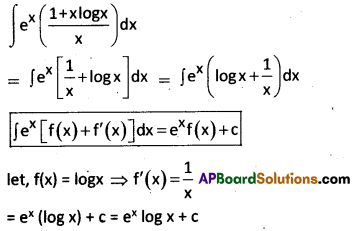
Question 7.
Find \(\int \frac{\sin \left(\tan ^{-1} x\right)}{1+x^2}\)dx, x ∈ R
Solution:
Put tan-1x = t then
\(\frac{1}{1+x^2}\)dx = dt
Now, \(\int \frac{\sin \left(\tan ^{-1} x\right)}{1+x^2}\)dx = ∫sin t dt
= -cos t + c
= -cos(tan-1x) + c
Question 8.
Evaluate : \(\int_0^{\pi / 2}\)sin5xcos4xdx
Solution:
Given \(\int_0^{\pi / 2}\)sin5xcos4xdx
= \(\frac{4+1}{5+4}\).\(\frac{4-3}{5+4-2}\).\(\frac{5-1}{5}\).\(\frac{5-3}{5-2}\)
= \(\frac{5}{9}\).\(\frac{1}{7}\).\(\frac{4}{5}\).\(\frac{2}{3}\) = \(\frac{8}{315}\)
Question 9.
Evaluate \(\int_0^2\)|1-x|dx
Solution:
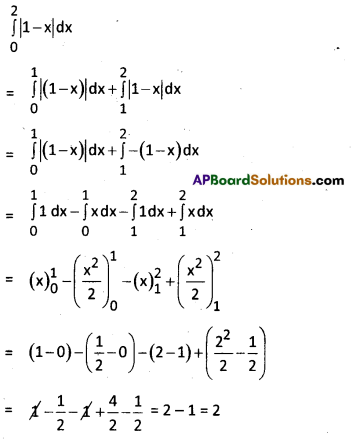
Question 10.
From the differential equation corresponding to
y = A cos 3x + B sin 3x, where A and B are parameters.
Solution:
Given y = A cos 3x + B sin 3x
then \(\frac{\mathrm{dy}}{\mathrm{dx}}\) = – 3A sin 3x + 3B cos 3x
\(\frac{d^2 y}{d x^2}\) = – 9A cos 3x – 9B sin 3x
= – 9(A cos 3x + B sin 3x) = -9y
∴ \(\frac{d^2 y}{d x^2}\) + 9y = 0 where A, B are eliminated.
Section – B
(5 × 4 = 20)
II. Short Answer type questions.
- Attempt ANY FIVE questions.
- Each question carries FOUR marks.
Question 11.
Find the equation of circle whose centre lies on the x-axis and passing through (-2, 3) and (4, 5).
Solution:
Let, the equation of the required circle is
x2 + y2 + 2gx + 2fy + c = 0 ……… (1)
Center of (1) c(h, k) = (-g, -f) lies on the x-axis then – k = 0 ⇒ f = 0
Since, (1) passes through the point (-2, 3) then
(-2)2 + (3)2 + 2g(-2) + 2f(3) + c = 0
4 + 9 + 4g – 6f + c = 0
4g + 6f + c = -13
If f = 0, then
-4g + 6(0) + c + 13 = 0
-4g + c + 13 = 0 ………….. (2)
Since, (1) passes through the point (4, 5) then
(4)2 + (5)2 + 2g(4) + 2f(5) + c = 0
16 + 25 + 8g + 10f + c = 0
8g + 10f + c +41 = 0
If f = 0 then 8g + 10(0) + c + 41 = 0
8g + c + 41 = 0 ……….. (3)
Solve (2) and (3)
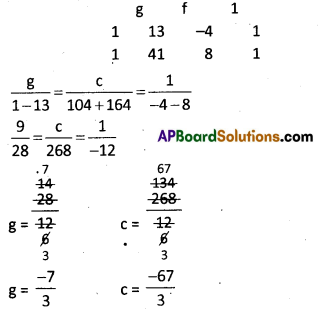
Now, substitute the values of g, f, c in (1)
x2 + y2 + 2g\(\left(\frac{-7}{3}\right)^x\) + 2(0)y – \(\frac{67}{3}\) = 0
3x2 + 3y2 – 14x – 67 = 0
∴ The equation of the required circle is 3x2 + 3y2 – 14x – 67 = 0
Question 12.
If x + y = 3 is the equation of the chord AB of the circle :
x2 + y2 – 2x + 4y – 8 = 0, find the equation of the circle having AB as diameter.
Solution:
Given equation of the straight line is L ≡ x + y – 3 = 0.
Given equation of the circle is g ≡ x2 + y2 – 2x + 4y – 8 = 0
Equation of the circle passing through A,B is S + λL = 0
x2 + y2 – 2x + 4y – 8 + λ, (x + y – 3) = 0 ………. (1)
x2 + y2 – (2 – λ)x + (4 + λ)y – (3λ + 8) = 0
Here g = \(\frac{(2-\lambda)}{2}\), f = \(\frac{4+\lambda}{2}\)
Centre of (1) s C = (-g, -f) = \(\left(\frac{2-\lambda}{2},-\frac{4+\lambda}{2}\right)\)
If \(\overline{\mathrm{AB}}\) is a diameter of circle (1) then ‘C’ lies on x + y – 3 = 0.
\(\frac{2-\lambda}{2}\) + \(\frac{-4+\lambda}{2}\) – 3 = 0
2 – λ – 4 – λ – 6 = 0 ⇒ 2A = -8 ⇒ λ = -4
∴ The equation of the circle on \(\overline{\mathrm{AB}}\) as a diameter is
x2 + y2 – 2x + 4y – 8 – 4(x + y – 3) = 0
⇒ x2 + y2 – 6x + 4 = 0
![]()
Question 13.
Find the equation of tangent and normal to the ellipse 9x2 + 16y2 = 144 at the end of the latus rectum in the first quadrant.
Solution:


Question 14.
Find the value of ‘k’ if: 4x + y + k = 0 is a tangent to the ellipse x2 + 3y2 = 3.
Solution:
Given equation of the ellipse is x2 +3y = 3
\(\frac{x^2}{3}+\frac{3 y^2}{3}\) = 1 ⇒ \(\frac{x^2}{3}+\frac{y^2}{1}\) = 1
Here a2 = 3, b2 = 1
Given equation of the straight line is 4x + y + k = 0 …………. (1)
y = -4x – k
Comparing with y = mx + c we get m = -4, c = -k
Since eq. (1) is a tangent to the given ellipse then
c2 = a2m2 + b2
(-k)2 = 3(-4)2 + 1 ⇒ k2 = 49 ⇒ k = ±1
Question 15.
Find the equations of the tangents to the hyperbola :3x2 – 4y2 = 12 which are :
- Parallel and
- Perpendicular to the line : y = x – 7.
Solution:
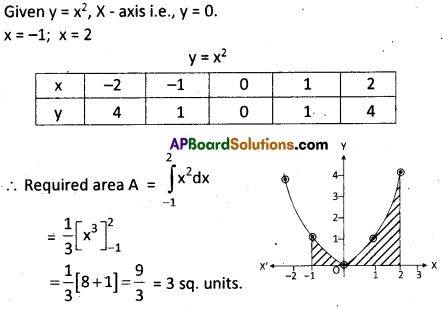
Question 16.
Find \(\int_0^{\pi / 2} \frac{d x}{4+5 \cos x}\)
Solution:
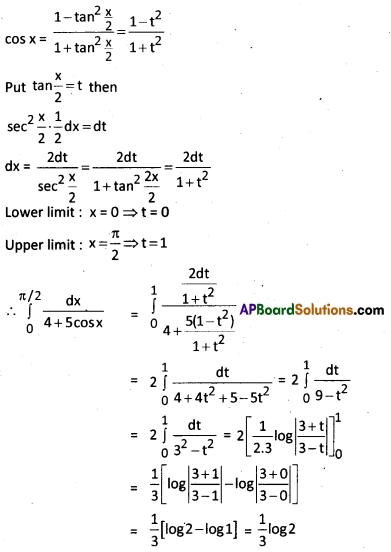
Question 17.
Solve the differential equation : (xy2 + x) dx + (yx2 + y) dy = 0.
Solution:
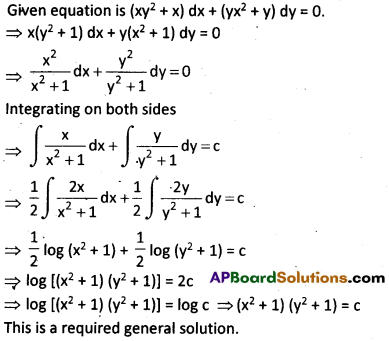
Section – C
(5 × 7 = 35)
III. Long Answer type questions.
- Attempt ANY FIVE questions.
- Each question carries SEVEN marks.
Question 18.
If (2, 0), (0,1), (4, 5) and (0, C) are concyclics then find ‘C’.
Solution:
Let, the equation of the required circle is
x2 + y2 + 2gx + 2fy + c = 0 ……. (1)
Since (1) passes through the point (2, 0) then
(2)2 + (0)2 + 2g(2) + 2f(0) + 0 = 0
4 + 4g + c = 0 ⇒ 4g + c = -4 ……… (2)
Since (1) passes through the point (0, 1) then
02 + 12 + 2g(0) + 2f(1) + c = 0
1 + 2f + c = 0 ⇒ 2f + c = -1 ……. (3)
Since, (1) passes through the point (4, 5) then
(4)2 + (5)2 + 2g(4) + 2f(5) + c = 0
16 + 25 + 8g + 10f + c = 0
8g + 10f + c = – 41 ……….. (4)
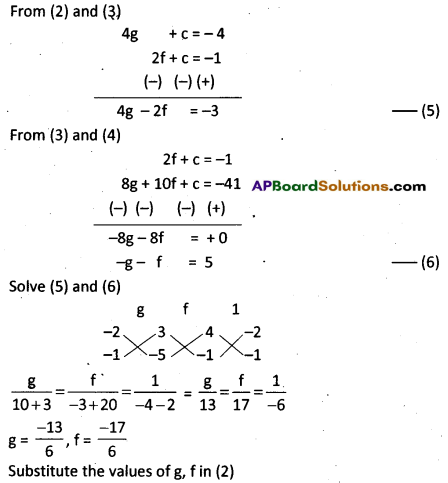

Substitute the point (0, c) in (7)
3(0)2 + 3c2 – 13(0) – 17c + 14 = 0
3c2 – 17c + 14 = 0
3c2 – 3c – 14c + 14 = 0
3c(c – 1) – 14(c – 1) = 0
(c – 1) (3c – 14) = 0
c – 1 = 0 3c – 14 = 0
c = 1 c = \(\frac{14}{3}\)
∴ c = 1 or \(\frac{14}{3}\)
Question 19.
Find the transverse common tangents of the circles : x2 + y2 – 4x – 10y + 28 = 0 and x2 + y2 + 4x – 6y + 4 = 0.
Solution:
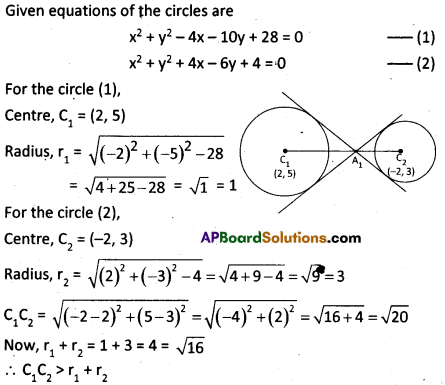
∴ Given circle are each circle lies completely outside the other.
Let, A1 be the internal centre of similitude.
The internal centre of similitude A1 divides C1C2 in the ratio r1 : r2 (1 : 3) internally.
∴ The internal centre of similitude
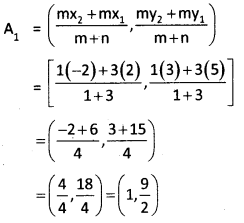
The equation to the pair of transverse common tangents is SS11 = \(S_1^2\)
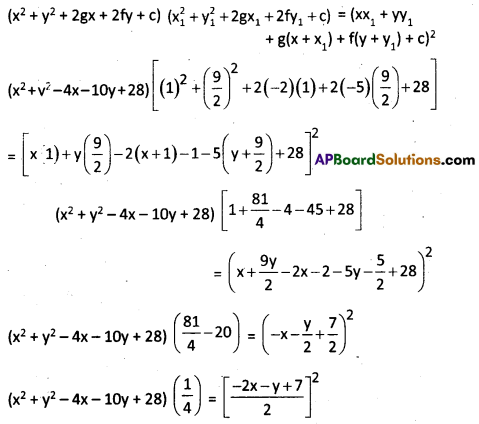
(x2 + y2 – 4x – 10y + 28) = (-2x – y + 7)2
x2 + y2 – 4x – 10y + 28 = 4x2 + y2 + 4g + 4xy – 14y – 28x
3x2 + 4xy – 24x – 4y + 21 = 0
consider 3x2 + 4xy = 0
x(3x + 4y) = 0
x = 0 and 3x + 4y = 0
∴ 3x2 + 4xy – 24x – 4y + 21 = (x + 1)(3x + 4y + k)
Comparing coefficient of x on both sides we get
k + 3l = -24 …… (3)
Comparing coefficient of x on both sides we get
4l = -4
l = -1
Substitute the value of l in (3)
k + 3(-1) = -24
k – 3 = -24
k = -24 + 3
k = -21
∴ The equation of the transverse common tangents are x – 1 = 0 and 3x + 4y – 21 = 0
Question 20.
Evaluate: \(\int \frac{2 \cos x+3 \sin x}{4 \cos x+5 \sin x}\)dx
Solution:
Let,
2cosx + 3sinx = λ\(\frac{\mathrm{d}}{\mathrm{dx}}\)(4cosx + 5sinx) + μ(4cosx + 5sinx x) + γ
= λ(-4sinx + 5cosx) + μ(4cos x + 5sin x) + γ …….. (1)
= 4λ.sinx + 5λcosx + 4μcosx + 5μsinx + γ
Comparing the coefficients of cos x on both sides, we get
5λ + 4μ = 2 ………. (2)
Comparing the coefficients of sinx on both sides, we get
-4λ + 5μ = 3 ………. (3)
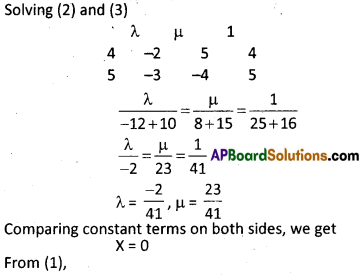
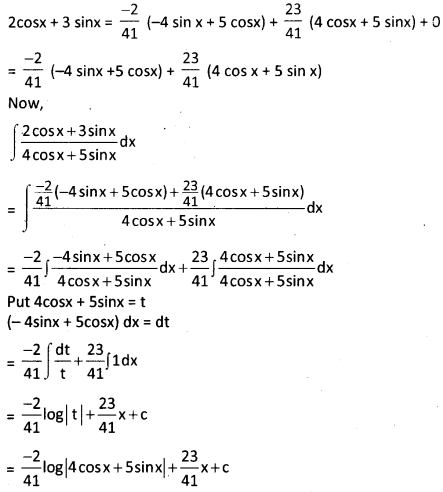
Question 21.
Obtain reduction formula : ∫tannx dx for integer n ≥ 2 and evaluate: ∫tan6xdx.
Solution:


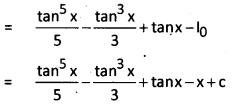
Question 22.
Derive the standard form of the parabola.
Solution:
The equation of a parabola in the standard form is y2 = 4ax.
Let, ‘S’ be the focus and L = 0 be the directrix of the parabola.
Let, ‘P’ be a point on the parabola.
Let, M, Z be the projections (Foot of the ⊥rs) of P, S on the directrix,
L = 0 respectively. .
Let, N be the projection of P and SZ.
Let, A be the mid point of SZ.
Since, SA = AZ, A lies on the parabola.
Let, AS = a. Take AS, the principle axis of the parabola as X-axis and AY perpendicular to SZ as y-axis. ,
Then, S = (a, 0) and the parabola is in the standard form.
Let, P = (x, y)
Now, PM = NZ = AN + AZ = x + a
The equation to the parabola is

![]()
Question 23.
Evaluate \(\int_0^\pi \frac{x \sin x}{1+\sin x}\)dx
Solution:
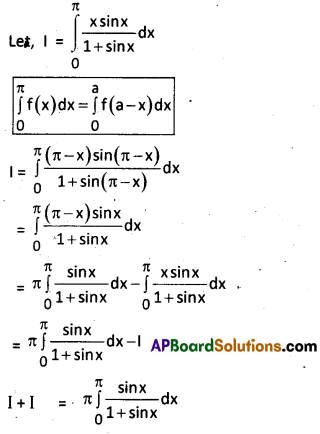
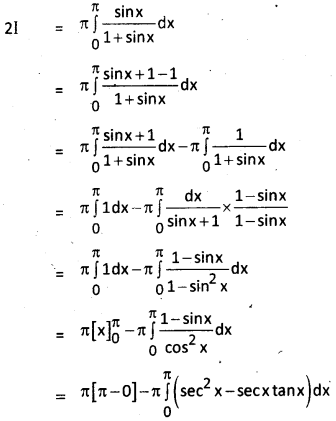
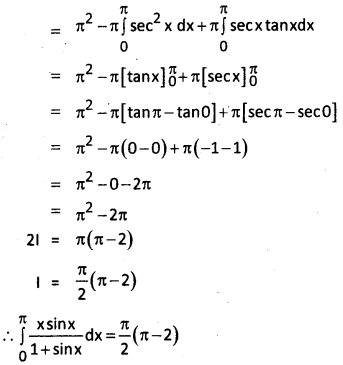
Question 24.
Solve : (1 + y2)dx = (tan-1y – x)dy.
Solution:
